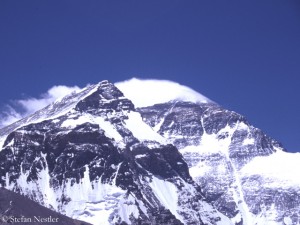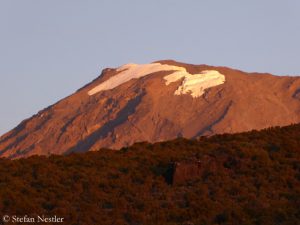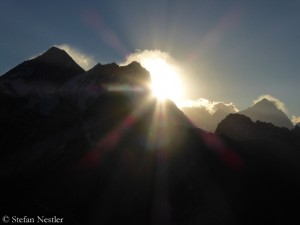Search Results for Tag: High altitude sickness
Missing on Kili: Humility and respect
The summit certificate is lying at home, so I could actually tick off Kilimanjaro. But Africa’s highest mountain is still on my mind half a week after my return home. My feelings were too ambiguous during the eight days on the highest mountain in Africa. On the one hand I was able to experience hospitable and helpful Tanzanians, a harmonious expedition team and a really impressive nature. The ascent through the various vegetation levels gave me many unforgettable moments. On the other hand, I realized once more the downsides of mass tourism on the mountains.
![]() read more
read more
Wedge pillow in the backpack?
Compared to the highest peak on Mars, Mount Everest is a dwarf. Olympus Mons rises 26 kilometers above the surface of the red planet. However, this is not the reason why the German Aerospace Center (DLR) deals with high altitude sickness. For a – as I find, very interesting – study, the DLR is looking for mountaineers, who will ascent in the period from 7 to 20 August after a night on the Gnifetti Hut (at 3,647 meters) to the Margherita Hut. The “Capanna Regina Margherita” is located on the summit of the Signalkuppe in the Valais Alps and is, at 4,554 meters, the highest building in Europe. The DLR scientists want to find out whether it helps against high altitude sickness if climbers are sleeping with a raised upper body. The test persons will use wedge pillows, which ensure that they are raised by 30 degrees. In intensive care units in hospitals such pillows have been used successfully for a long time.
Mountaineers who want to participate in the study at the Regina Margherita mountain hut in August can either register by email at ams@dlr.de or register at the valley station in Alagna or the Gnifetti Hut with the DLR study supervisors. I have talked to Dr. Ulrich Limper who heads the study. The 35-year-old doctor has been working at the DLR for three years.
Dr. Limper, why is an aerospace center interested in the health problems of mountaineers? Are there similarities between astronauts and climbers?
![]() read more
read more
Liaison officer dies of high altitude sickness
Death on the Everest winter expedition: However, none of the climbers died but a government official. According to the Kathmandu-based newspaper “The Himalayan Times” the liaison officer, who was to accompany the winter expedition of the Basque Alex Txikon on behalf of the Tourism Ministry, died of high altitude sickness. The man passed away on the flight from Dukla (4,600 meters high) to Lukla (2860 meters) where he was to be treated in the hospital. The Spaniards Alex Txikon and Carlos Rubio want to climb Mount Everest without bottled oxygen this winter. The team has meanwhile – as reported – pitched up Camp 1 at 6,050 meters above the Khumbu Icefall.
![]() read more
read more
Oswald Oelz: “Mountaineers are unteachable”
“I will climb until I am dead,” says Oswald Oelz, sitting opposite me recently at the International Mountain Summit in Bressanone. The 73-year-old native of Austria lives as a retiree in an old farmhouse in the Zurich Oberland region in Switzerland. “I have a farm with sheep, parrots, ducks, geese, chickens. I write, read a lot, climb. And I travel around the world.” Oswald called “Bulle” Oelz scaled Mount Everest in 1978, on the same expedition, during which Reinhold Messner and Peter Habeler climbed the highest mountain on earth for the first time without bottled oxygen. Oelz succeeded first ascents in the Alps, in Alaska, Jordan and Oman. Until 2006 he worked as chief physician at the “Triemli hospital” in Zurich. The professor also researched in the field of high altitude medicine.
Oswald Oelz, you are a mountaineer and a doctor, you have got to know both worlds. Time and again, there are fatalities in the high mountains due to high altitude cerebral or pulmonary edema. Has the climbing community learned nothing over the past decades?
![]() read more
read more
Two dead on Everest
 Not a good day on Mount Everest. The Nepalese expedition operator Seven Summit Treks had to report two deaths on Saturday. On the South Col, at an altitude of almost 8,000 meters, first the Dutchman Eric Arnold died and later the Australian Maria Strydom, both were obviously suffering from altitude sickness. Arnold, 35 years old, had reached the summit before and was on descent, the 34-year-old Strydom had apparantly abandoned her summit attempt.
Not a good day on Mount Everest. The Nepalese expedition operator Seven Summit Treks had to report two deaths on Saturday. On the South Col, at an altitude of almost 8,000 meters, first the Dutchman Eric Arnold died and later the Australian Maria Strydom, both were obviously suffering from altitude sickness. Arnold, 35 years old, had reached the summit before and was on descent, the 34-year-old Strydom had apparantly abandoned her summit attempt.
![]() read more
read more
Children on Everest? Irresponsible!
 A twelve-year-old boy on top of Everest? Professor Thomas Kuepper can only shake his head. The occupational health and sport physician at the University Hospital Aachen is an internationally recognized authority on high altitude medicine who is also advising the International Climbing and Mountaineering Federation (UIAA). I had asked him what he thinks about the American Tyler, aged eleven today, who – as reported in my blog – wants to climb Mount Everest next spring. “You should file a charge of child abuse”, Kuepper wrote back disgustedly.
A twelve-year-old boy on top of Everest? Professor Thomas Kuepper can only shake his head. The occupational health and sport physician at the University Hospital Aachen is an internationally recognized authority on high altitude medicine who is also advising the International Climbing and Mountaineering Federation (UIAA). I had asked him what he thinks about the American Tyler, aged eleven today, who – as reported in my blog – wants to climb Mount Everest next spring. “You should file a charge of child abuse”, Kuepper wrote back disgustedly.
![]() read more
read more









Feedback